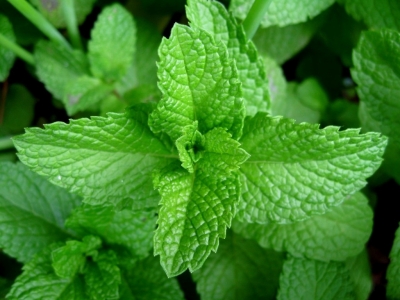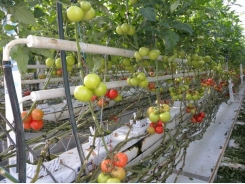Mint Farming Information Guide

Health Benefits of Mint
Introduction of Mint:– Mint is one of the popular herb cultivated for its aroma, culinary use and medicinal properties throughout the world. Mint belongs to the family of “Labiatae” and genus of “Mentha”. Mentha oil is derived from a common mint. It is an aromatic annual herb plant having pleasant odour leaves and is classified as an industrial crop. The end product of Mentha oil is extracted from the mint leaves by processing and steam distillation. In most of the Asian countries, mint is used in dish preparations for better flavour and aroma. Mint is a commercial crop and has huge demand for its leaves due to its medicinal uses. One can get decent profits with mint farming provided proper mint cultivation practices are followed. The mint is originated from Brazil and China. However, India is the top producer of this essential oil yielding plant. Mint can be grown in pots, containers, on terrace and commercial cultivation can be carried out in open fields, greenhouse, polyhouse, shade net and hydroponic systems. Mint agriculture is increasing day by day especially in Asian countries. Commercial cultivation of Japanese Mint, yielding menthol is a huge success in Asian countries such as India, China, and Thailand.
Uses and Health Benefits of Mint:- The health benefits and uses of mint include the following:
Health Benefits:
- Mint leaves are good for Digestion.
- Mint is a good remedy for Nausea & Headache.
- Regular use of Mint is beneficial in Asthma Patients.
- Mint oil helps Breast Feeding women.
- Mint aroma helps in reducing Depression & Stress.
- Mint juice is excellent for Skin Care and Pimples.
- Mint reduces the Memory Loss.
- Mint helps in Weight Loss.
- Mint may help in preventing Allergies and Hay Fever.
- Mint may help in preventing and treat cancer.
- Mint is being used in herbal products.
Industrial Uses of Mint: Industrial use of mint in foods like ice-cream, chocolates, alcoholic and nonalcoholic beverages, medicines, cosmetics, inhalers and breath fresheners. It is also being used in condiment and culinary preparation around the world.
Major Mint Production Countries:– The following are the major mint production countries in the world.
| Mint Name | Top Production Countries |
| Japanese mint | India, China and Brazil. |
| Peppermint | USA, France, former USSR, Brazil and India. |
| Bergamot mint | USA, Brazil and Thailand. |
| Spearmint | USA, China, former USSR and India. |
Local Names of Mint in Asia:- Pudina (Hindi/India), Padina (Nepali), Pudina (Urdu), Rаа (Mongolian), ناعْعـَ (Arabic), 薄荷 (Chinice), ใบมนิ ท์(Thai), Bạc hà (Vietnamese), Seiyo-Hakka, 造幣局 (Japanese),ටංකණ (Sinhalese), Myata (Russian),Nane, Darphane (Turkish), 薄荷 (Taiwanese),Daun Pudina (Malay), 민트 (Korean), Pudina Patta (Hindi), Puthina/Pudhinaa (Tamil), Pudina (Telugu),Pudina (Kannada), Pudina (Marathi),Hara Pudina (Punjabi), Fudino / Phodina (Gujarati), Putiyina/Pudhinaa (Malayalam), Pudyanu (Kashmiri).
Mint Varieties:- The following are the most commonly cultivated mint varieties.
- Japanese Mint/Menthol Mint (arvensis).
- Spearmint ( spicata).
- Peppermint (piperita).
- Bergamot mint ( citrata).
Climate Required for Mint Farming:- Mint can be cultivated both in tropical and sub-tropical regions. The ideal temperature between 20°C to 40°C is required throughout growing period of mint. Evenly distributed rain fall of 100 cm to 120 cm and good sunshine during harvest is best suitable during crop growth.
Soil Requirement for Mint Farming:- Mint can be successfully cultivated on both red and black soils. However, well-drained sandy loam or loam soils rich in organic matter is best suited for its cultivation. The soil pH between 6.0 and 8.5 is recommended. Commercial growers should go for soil testing before cultivation. In case of acidic nature soils with pH less than 5.5 should be added with lime.

Growing Mint in Container
Pot Growing Tips in Mint Farming:-
Do’s:
- Select a location for your mint where the plant will receive morning sunlight and partial afternoon shade.
- Make sure to plant on a patio, in a container.
- When planting the mint seedling in a flower bed, first submerge a container (either a pot, a mesh bag or edging to at least 5 inches deep), leaving the rim above ground level when potted, so the mint’s fastgrowing root system will be contained.
- Otherwise, the herb will grow like any other weed.
- Harvest mint sprigs before the plant flowers.
- To extend the harvesting season of mint, pinch off the flowering buds as they appear on the plant.
- If planting your mint in a garden bed, apply mulch to help keep it from spreading or conserve moisture.
- Locate mint plants 15 inches apart, and prune (thin) them on regular basis.
- If planting your mint indoors, locate your container where it will receive good morning sunshine but where it will also be away from drying heating elements.
Don’t:
- Plant mint in an open bed without first submerging a vessel that will contain the herb’s wild-growing roots.
- If planting mint in a bed using a submerged pot, be sure it’s not cracked. The “runners” will find their way out and continue to spread.
- Plant the herb in super moist conditions where it won’t dry out as it requires uniform moisture conditions.
Land Preparation, Seed Rate, Spacing and Plantation in Mint Farming:- Land should be given couple of ploughings and 2 cross harrowing to bring the soil to fine tilth stage.
Supplement the field with 25 to 30 tonnes of well rotten farm yard (FMY) in the last ploughing.
On an average 500 to 600 suckers should be planted in 1 hectare land. Suckers should be set in furrows 5 cm to 1 cm deep with a spacing of 60 to 80 cm. Plant the suckers end to end and cut the suckers into 10 cm to 12 cm length before sowing the mint seedlings. Plants should be spaced 30 cm apart in rows 60 cm apart. Sowing the mint just before onset of monsoon is recommended.

Growing Mint in Pots
Propagation and Raising Seedlings in Mint Farming:- Propagation is done through Suckers, (runners or Rhizomes)

Mint Seedlings
Manures and Fertilizers in Mint Farming:- Fertilizers and manures are very important tasks for better yield of mint. As we said before, supplement the main filed with 25 tonnes of FMY during the land preparation .Chemical fertilizers of N : P: K should be applied in the ratio of 50:75:40 kg/ha as basal dose. Top dressing application of 75 kg of ‘N’/ha in 3 equal doses should be applied.
Irrigation in Mint Farming:- For better growth and yield, mint crop requires considerable moisture throughout its growth cycle. As the roots of mint do not t penetrate deep into the soil, light and frequent irrigations should be provided. In case of hot and dry weather conditions, irrigate the crop frequently. Before irrigation, it is better to check the soil moisture and provide water based on the soil moisture content.

Mint Farming in Polyhouse
Intercultural Operations/Weed Control in Mint Farming:- Carry out the regular weeding operations to make the topsoil loose for better penetration of air, water and light. As mint roots don’t penetrate deep, shallow or light weeding is required.
Pests and Diseases in Mint Farming:- The following are the pests, diseases and their control measures in mint farming.
Hairy Caterpillar, Red Pumpkin Beetle, Cutworms and Mint Leaf Roller are the main pests found in mint cultivation.
Pest Control Measures:
- Hairy Caterpillar: Apply Thiodan or Malathion @ 1.7ml/ litre of water.
- Red Pumpkin Beetle: Spray Malathion @ 1ml/ litre of water.
- Cutworms: Soil treatment should be done with Phorate 10 grams before planting the mint.
- Mint Leaf Roller: 2 to 3 sprayings of Thiodan @ 1.5ml /litre of water at weekly intervals.
Stolon Rot, Fusarium Wilt and Leaf blight are the common diseases found in mint farming.
Diseases Control measures:
- Stolon Rot: Crop rotation. It is better to follow three year-crop rotation with rice, wheat and mint. Treatment of the stolons with 0.25 % of solution of Captan or 0.1 % of Benlate, 0.3 % of Agallol solution for 2 to 3 minutes before planting is a preventive measure.
- Fusarium Wilt: Apply Benlate, Bavistin and Topsin.
- Leaf blight: Apply copper fungicide.
Crop Rotation in Mint Farming:- The rotation of mint crop with other food crops is found to be beneficial in controlling weeds. Continuous cropping of mint is not advisable and the best rotation of Mint crop is: Rice – Mint: Potatoes – Mint: Any vegetables – Peas.
Harvesting in Mint Farming:- Harvesting of mint crop should be carried out 2 to 3 times in a year i.e. once in 4 months. Harvest the first crop before the onset of monsoon (June to July) and second harvesting should be done after the monsoon period (Sep to Oct).Third harvesting should be done in Nov to Dec month.
Post Harvesting in Mint Farming:- There are some activities should be carried out after the harvesting process is over. The material left after distillation of oil is called spent grass. It can be used for mulching or as manure in citronella fields. It can also be used for making paper and paper boards and citronella oil must be packed in air tight containers of glass, tin or aluminum. Containers are stored in a cool place away from light and heat. Oil changes its colour from yellow to green if it is exposed to light or heat.
Yield in Mint Farming:- The average yield is 20 to 25 tonnes of fresh herbage per ha based on the cultivar. In two harvests, which, in turn, yields around 250 to 300 kg? of oil in a year.
Có thể bạn quan tâm
Phần mềm

Phối trộn thức ăn chăn nuôi

Pha dung dịch thủy canh

Định mức cho tôm ăn

Phối trộn phân bón NPK

Xác định tỷ lệ tôm sống

Chuyển đổi đơn vị phân bón

Xác định công suất sục khí

Chuyển đổi đơn vị tôm

Tính diện tích nhà kính

Tính thể tích ao hồ




 How To Remove Tomatoes Stem and Why We…
How To Remove Tomatoes Stem and Why We…  Tomato Farming Information Guide
Tomato Farming Information Guide